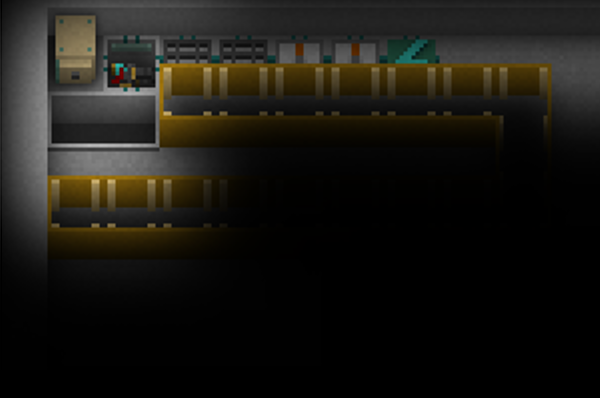Sneaking into Rohrer's Castle - Part 1
The Castle Doctrine is Jason Rohrer's latest game, a home defense MMO. You can rob thousands of other players while they are away from their virtual homes. Of course, they can rob you too. The only thing preventing any of these robberies is elaborate, deadly traps created by homeowners. Sound like a neat concept for an MMO? It is.
I got into the pre-alpha and was absolutely blown away. Every single night for a week, The Castle Doctrine had me staying up into the late hours carefully tweaking my traps and eagerly waking up in the morning to see which unlucky souls had fallen for them. I died myself dozens of times, yet I kept coming back.
But then something strange happened. I noticed a stream of lukewarm articles coming from the gaming press. There was apprehension about the politics involved. There were complaints about lack of a tutorial. I was confused. Why was nobody talking about how fun this game is?

This is how you get got
Let's start with what The Castle Doctrine isn't.
It isn't an easy game. You always have one hit point. One misstep means death and when you die, you lose everything. There's undoubtedly a learning curve, but beyond that learning curve there is also a never ending arms race. As defenses get better, robbers get better. They get smarter, richer, and better equipped. Old tricks stop working. No matter how clever you are, no matter how convoluted your house becomes, it will eventually be solved or worse.... it will be copied.
It isn't a game you play with friends. Don't let "MMO" give you the wrong impression. There is no social aspect to the game: no chat, no guilds. When you want to rob someone, you select from a cold list of strangers (the website makes at least one reference to looking up names in a phone book). You're not even told your own (randomly generated) name. You can't make friends in The Castle Doctrine. But you can make enemies.
A confession
Now, I admit that I'm a big fan of Rohrer. I want to get that out of the way. He won the GDC Game Design Challenge not once, but twice. Besides consistently churning out thought provoking games, the guy has a damn interesting backstory: he lives with his family of five on a budget of about $14,500 a year. He once fought and won a court battle against the city of Potsdam, NY for the right to grow a meadow.
But here's my guilty confession: I never found a single one of Rohrer's games to be very fun. Passage was quite interesting, but it's hard to make memento mori fun. A friend bought Sleep is Death, but we never could get into it. Inside a Star-filled Sky was OK. I had accepted that I would continue to play Rohrer's games and that they would be clever and interesting, but not much fun and not very deep. This game, however, has proved me very wrong.
ROGUELIKE WILL NEVER DIE, BUT YOU WILL... a lot
The essence of The Castle Doctrine, the thing that makes it so frustrating at times and immensely satisfying at others, is that it is a roguelike. Here's a quick primer on roguelikes in case you've been living in a (non-randomly generated) cave. Roguelikes are games that feature elements of the 1980 game Rogue. There is no single definition, but randomness and permadeath are key elements. I'll reluctantly quote the Berlin Interpretation (but please don't tell Darren Grey):
"Random environment generation The game world is randomly generated in a way that increases replayability..."
Technically, The Castle Doctrine is pseudorandom, since other players create the environment. But many of the same ideas still apply.
Rogue was created partly because its authors were tired of games being predictable. What better way to avoid that problem than to create a system in which predictability is actively discouraged; after all, your best defensive tools in The Castle Doctrine are trickery and confusion. There's an additional benefit to user created "dungeons." With random generation, you either have to make random elements too easy or face the possibility of unfair and impossible situations. The Castle Doctrine avoids that issue by forcing you to navigate your own house and get to your own safe without dying before you can submit your house. It's the best of both worlds: players have an incentive to make their houses as deadly as possible, but those houses are guaranteed to be, at the very least, beatable.
"Permadeath You are not expected to win the game with your first character. You start over from the first level when you die... The random environment makes this enjoyable rather than punishing."
Read that again. Dying. Is. Enjoyable. Aye, there's the rub. In order to enjoy this game, you must enjoy dying a lot. Dying here means starting over from scratch: you lose your house, your items, and your money... potentially hours of hard work. High difficulty and permadeath are hard concepts for your average gamer to grok. It's no secret that gamers today are coddled. But in a game with no danger, there's no tension. Choices aren't meaningful if making a bad one has no effect. Roguelikes are incredibly riveting because you always face the real possibility of losing everything.

It's this possibility that makes validating houses in The Castle Doctrine one of the most intense experiences I have ever encountered in a video game. You're required to go through your house just like an intruder. Your traps will kill you. Your own pit bulls will maul you. The worst part is you're not even allowed to use offensive items, like crowbars, that would otherwise help get you out of a bind.
I once made a confusing maze that ended in a series of hallways filled with electric floors. Go down the wrong hallway and get swiftly electrocuted. I had developed a habit of validating the house "cold" (leaving extra exits or removing key components) before doing a live fire exercise. So I ran through a few times and everything worked flawlessly. I quickly added in several pit bulls that would chase close behind and closed up the extra exits. It was go time. I methodically selected the rights doors, navigated the maze, and got to the right hallway. But then I noticed something was wrong; I had miscalculated and added one pit bull too many. The last one toggled a switch behind me that electrified the floor and left me stranded on one safe tile. Your standard run, gun, and respawn-at-checkpoint game has never gotten close to creating the feeling I was experiencing at that moment, best described as "pit in stomach."
Continued in Part 2.
Vote on HNDiscuss on Hacker News, you know, if that's like your thing.
Permalinks
Short: http://jere.in/1Pretty: http://jere.in/sneaking-into-rohrers-castle-part-1
